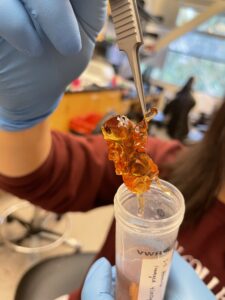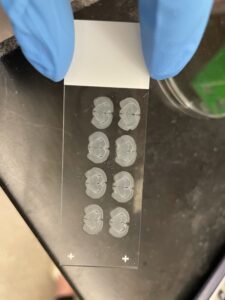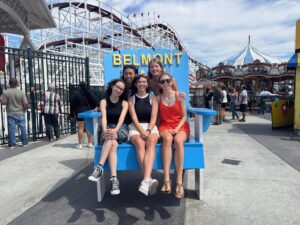Hi everyone! My first week in San Diego has been amazing! I am lucky enough to be interning at the Ye Lab within the Dorris Neuroscience Center at the Scripps Research Center. I am interning under the guidance of my incredible mentor Cailynn Wang and her research on CATCH (or clearing-assisted tissue click chemistry). My other mentor, Zhengyuan (Ben) Pang was one of the scientists who helped develop CATCH, which utilizes alkyne-modified drugs and fluorescent stains to visually demonstrate a particular drug’s distribution within tissue in order to create safer and more effective drugs that can target specific areas and have minimal side effects.
I arrived Saturday afternoon and got settled and met my fellow pinterns: Maiya, Reign, Shiloh, and Azari. Then we all explored, (and went to Target and Trader Joes) on Sunday before our first days at the lab on Monday. My first day began with the weekly lab meeting where one of post-docs in my lab gave a data update on his project, which was related to my mentor’s work on CATCH. Then, my mentor gave me some papers to read so I could familiarize myself with the lab equipment and hazardous chemicals I would be working with. I also learned more about the tissue clearing process, called CLARITY, which enables large (or even whole) tissue samples to be rendered transparent so they can be imaged in 3D without needing to be sliced and digitally regrouped. The tissue is cleared through four steps which seek transparency by homogenizing the RIs (refractory index) of the tissue because when all the RIs are the same there is less light scattering and therefore higher transparency of the sample. After an early finish, my fellow interns and I drove downtown and explored near seaport village.
Day 2 began with a lesson about the click chemistry reactions that are vital in the CATCH technology. Cailynn uses the most common click reaction, which has a copper catalyst, to bind the alkyne drug (Cailynn’s research uses ketamine) with an azide found in the buffer solution of the mice. The alkyne drug is then “tagged” with the fluorescent azide when the two molecules bond and we are able to see where the drug has been distributed under a microscope. In the afternoon I watched one of the PhD students perform a transcardial perfusion, which is where mice are sacrificed and phosphate buffered saline (PBS) is pumped through the left ventricle and throughout the mouse’s body, effectively removing its blood so that its tissue can be cleared properly. A paraformaldeyhde (PFA) perfusion follows the PBS one, which fixes the tissue so it will be harder and less likely to be damaged during sectioning. After the mice have been perfused, their organs are harvested and cleared and they are ready for imaging!

A cleared mouse body with intact bones and organs that are invisible because they have been RI matched and had their lipids removed.
Day 3 was by far the most hands-on day and I began by viewing one of the PhD student’s (Logan) research in which he had to sacrifice and perfuse five mice. After watching him perfuse and dissect a few times I even got to give it a go myself! Logan helped me cut through the diaphragm to expose the heart but then I put the needle into the left ventricle (and not the right ventricle because that accesses the respiratory system rather than the desired circulatory system) and began the perfusion all by myself. After that, Logan walked me through cutting the skull and removing its flaps to expose the brain, and I successfully removed the mouse’s brain with the cerebellum and brain stem intact! After lunch, I was planning on assisting Cailynn inject the alkyne drug into the mice for her experiment, but there was an insufficient amount of reagent needed for the CLICK reaction so it was delayed. So, I helped her weigh the mice in the vivarium and needed to put on scrubs, a hair net, gloves, and shoe covers in order to enter. Weighing the mice is a crucial step because it ensures that they are given proper dosage of the drug. Later, I saw the Vibratome and Cryostat machines that are used when sectioning a tissue sample to ensure each slice is evenly cut and measured (usually they are sliced to a thickness of 100 micrometers, which is .01 centimeters!)
On Day 4 I began by helping Cailynn use the Cryostat machine to section some lung tissue and then transfer it to various containers. The transferral of the tissue is done with very tiny paintbrushes and is a very delicate process because the tissue is so thin that is tears easily. The lung tissue is quite interesting to view because you can see tiny holes in it from the bronchi where the oxygen and CO2 enter and exit the lung. After lunch, Cailynn showed me how to properly mount a slide. First, you carefully place the sectioned tissue pieces onto the glass plate using a brush, then you pour on a mounting chemical that makes the RIs of the tissue the same as the plate so they are more easily viewed under the microscope. Finally, you have to meticulously put on the glass top sheet without getting any air bubbles that could obstruct later viewing of the tissue on the slide. For my first practice I put 4 six brain slices on the slide and successfully finished it without accumulating any air bubbles!
On Friday (Day 5), I began by practicing proper pipette technique and carefully transferring varying amounts of water from one test tube to another. I also successfully mounted a slide for Cailynn’s experiments without any help! I did more research on the NMDA receptors in the cells and learned that when ketamine binds to it the NMDA receptor is inactivated and pain signals are blocked, allowing ketamine to have some antidepressant effects. Other than that, Friday was a pretty chill day at the lab as everyone was awaiting the weekend and that night’s summer lab barbecue at the PI’s (principal investigator) house, which turned out to be super fun!
On the weekend the other San Diego pinterns and I explored Mission Beach and the roller coasters at Belmont Park, which were a little scary and super fun! We enjoyed relaxing and soaking up the California sunshine after a pretty foggy week.



There are no comments published yet.